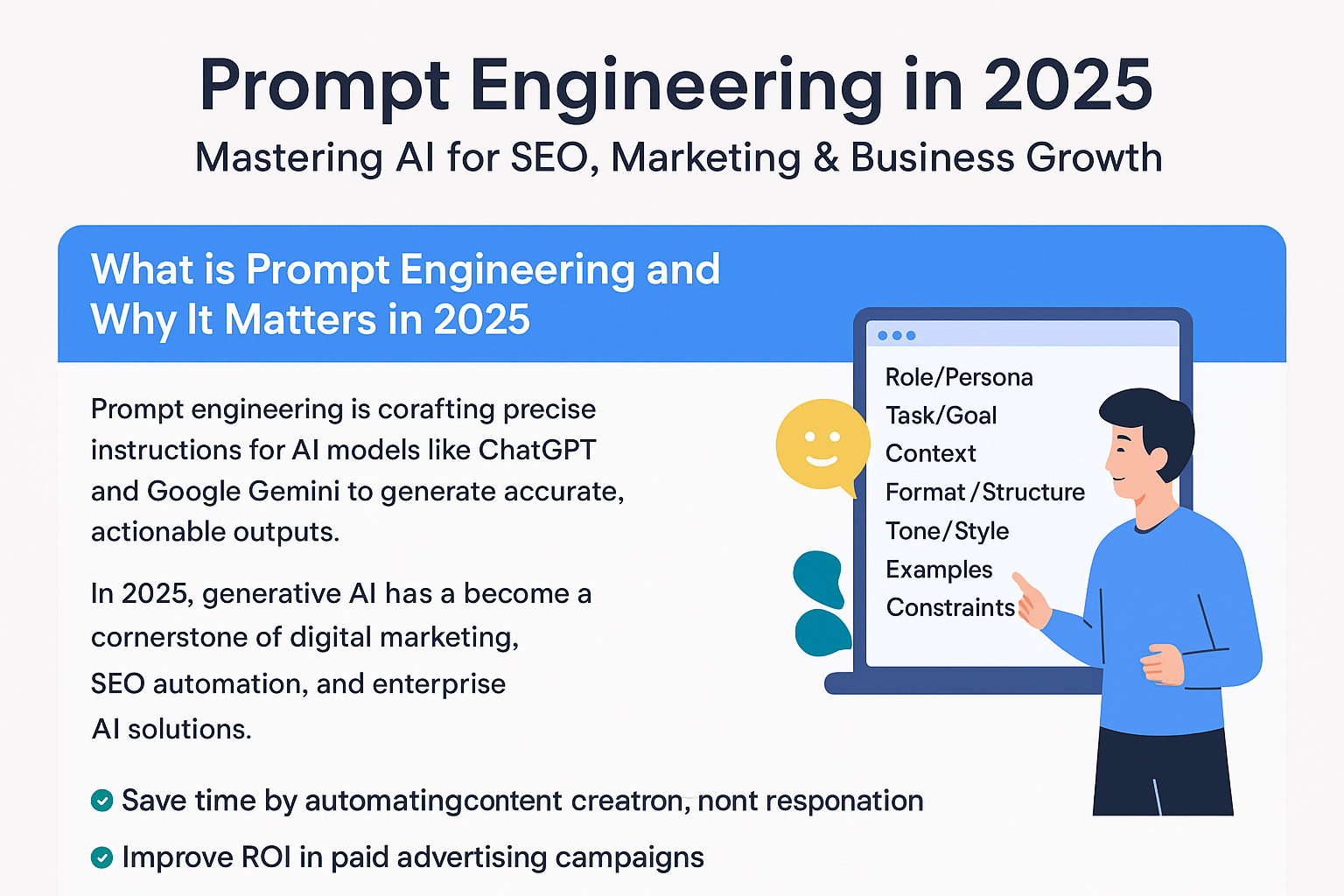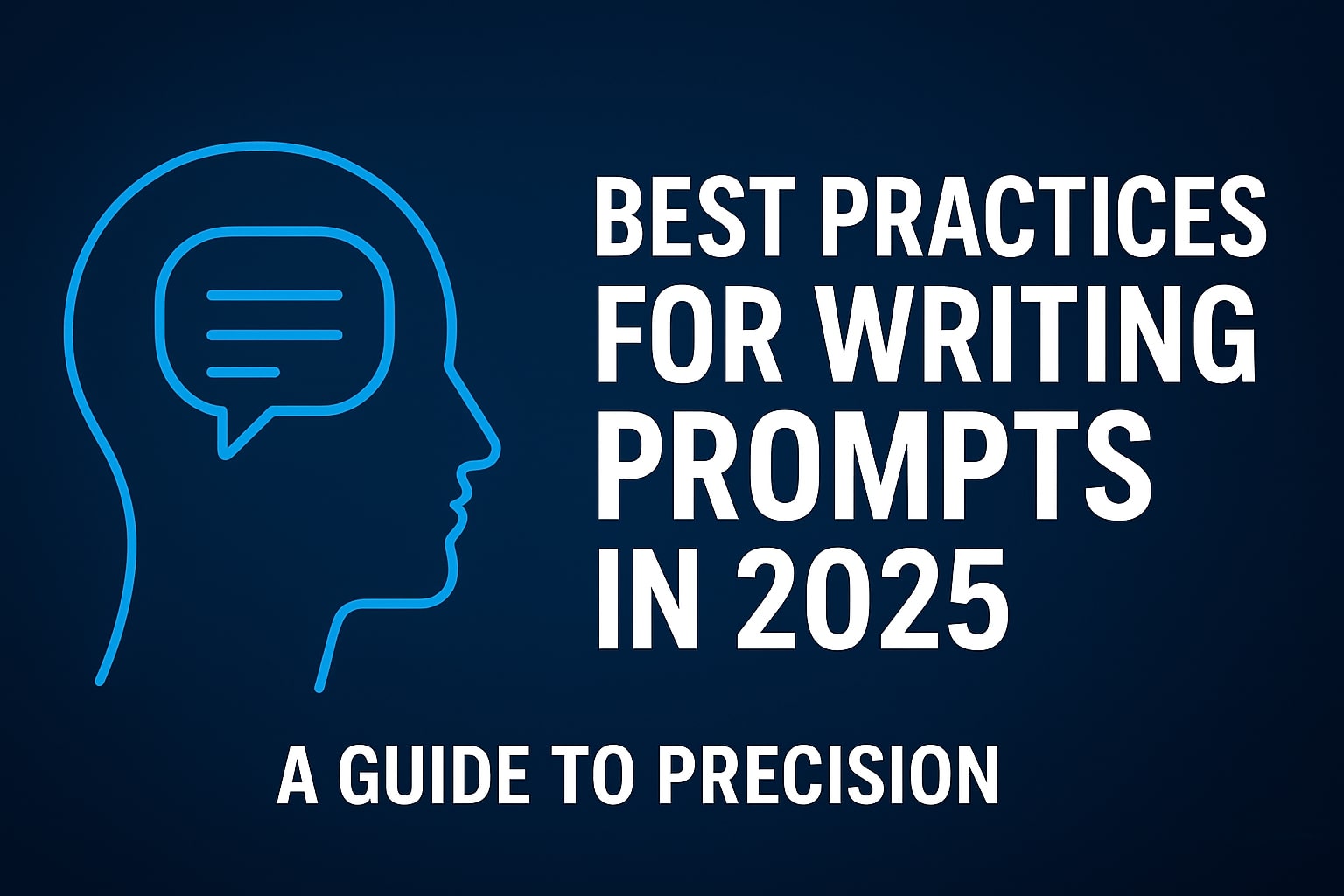What is Prompt Engineering and Why It Matters in 2025
Prompt Engineering is the art of crafting precise instructions for AI models like ChatGPT and Google Gemini to generate accurate, actionable outputs.
In 2025, generative AI has become a cornerstone of digital marketing, SEO automation, and enterprise AI solutions. Mastering prompt engineering means you can:
Save time by automating content creation.
Improve ROI in paid advertising campaigns.
Generate SEO-rich blog posts, product descriptions, and ad copies.
Create highly personalized customer experiences.
Think of prompt engineering as writing a brief for an ultra-literal assistant: the clearer your instructions, the better the AI performs.

Understanding Prompt Engineering for AI-powered workflows.
Anatomy of a Powerful Prompt
A high-performing AI prompt usually includes these 7 components:
Role/Persona: “Act as a senior SEO strategist specializing in e-commerce.”
Task/Goal: “Generate 10 blog post ideas about sustainable fashion targeting Gen Z.”
Context: “Audience is eco-conscious shoppers aged 18–30.”
Format/Structure: “Provide results in a bullet-point list with short summaries.”
Tone/Style: “Professional yet engaging, avoiding jargon.”
Examples (Few-Shot Learning): Provide a sample and ask AI to replicate style.
Constraints: “Keep blog titles under 60 characters.”
When combined, these elements transform generic AI output into SEO-friendly, business-driven content.
Best Practices for Prompt Engineering in 2025
Here are proven strategies digital marketers, content creators, and businesses can use:
✅ Be Specific: Instead of “Write a blog post,” say “Write a 1,000-word article on solar panels focusing on cost savings and environmental benefits.”
✅ Iterate & Refine: Treat prompts as drafts. Ask, “Make it more persuasive” or “Summarize in 100 words.”
✅ Use Positive Language: Frame outputs by telling AI what to do (e.g., “Use a helpful, educational tone”).
✅ Chain Prompts Together: Break large tasks into steps. Example:
Prompt 1: “Generate 5 SEO titles.”
Prompt 2: “Write an outline for the top-performing title.”
✅ Integrate Keywords Naturally: Always include high CPC keywords like AI marketing automation, business intelligence tools, AI for SEO, enterprise AI solutions.
Advanced Technique: Chain-of-Thought (CoT)
For complex reasoning—like keyword clustering, ad budget optimization, or long-form content strategy—use Chain-of-Thought prompting.
Tell the AI: “Think step by step before giving the final answer.”
This results in logical, well-structured outputs—ideal for data-driven SEO strategies and enterprise-level AI adoption.
Real-World Applications
SEO Automation: Use ChatGPT and Gemini for keyword research, content briefs, and backlink strategies.
E-commerce: Generate personalized product descriptions optimized for Google Shopping Ads.
Paid Ads: Create high-converting Google Ads & Meta Ads copy with A/B tested variations.
Enterprise AI Solutions: Automate customer support scripts, sales funnels, and lead nurturing.
Learn more: How ChatGPT and Gemini Are Changing SEO
FAQs on Prompt Engineering
Q1. Can prompt engineering improve Google Ads ROI?
Yes. By crafting conversion-focused prompts, AI can generate ad copy with higher CTR and lower CPC.
Q2. Is prompt engineering only for tech experts?
No. Marketers, bloggers, and entrepreneurs can all benefit with simple training.
Q3. Which AI tools are best in 2025?
ChatGPT (for conversational intelligence) and Google Gemini (for multimodal outputs).
Final Thoughts
Prompt Engineering in 2025 is no longer optional—it’s a core digital marketing skill. By mastering it, you unlock the full potential of AI tools for SEO, content marketing, paid advertising, and enterprise workflows.
Think of it as coding in plain English: the more precise your instructions, the more powerful your results.
Start experimenting today—your AI-powered competitive edge depends on it.
